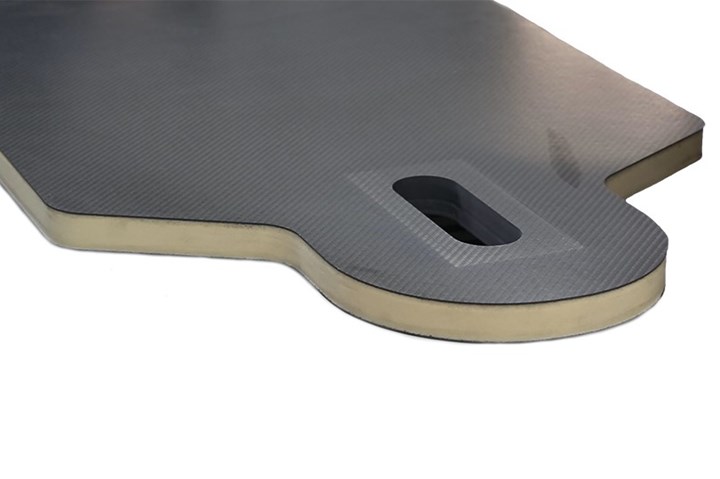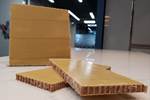Composite sandwich panels enable flexibility in medical table design
Polyurethane foam core provides a cost-effective option for ACP Composites’ specialized medical positioning table design.

Source | ACP Composites
Family-owned composites fabricator ACP Composites (Livermore, Calif., U.S.) supports a number of industries with its composite structures, plates, flat panels and other custom applications. One successful application of its sandwich composite panels is a carbon fiber composite patient positioning table designed for healthcare equipment company Broncus Medical Inc. (San Jose, Calif., U.S.).
According to Justin Sparr, CEO of ACP Composites, to meet customer requirements the table needed to be both lightweight and durable, transparent to x-ray radiation, and able to be easily machined to accommodate a specific type of insert for the attachment of medical instruments and clamps. To meet volume and cost requirements, the tables also needed to be produced cost-effectively with short lead times. Carbon fiber was chosen for its low energy absorption and low attenuation — meaning the material, unlike metal, reduces the intensity of the x-ray beams as they hit the surface, rather than scatter the beams and risk unnecessary exposure to the patient. ACP Composites chose Axiom Materials’ (Santa Ana, Calif., U.S.) 3K twill carbon fiber prepreg for use in the sandwich panels.
For the core, metal honeycomb core was not possible due to high attenuation, and polyacrylamide foam, which Sparr says is often used in these types of tables, was outside of the target price range and required expensive tooling to cure. For this application, ACP decided to use LAST-A-FOAM FR-3700 series polyurethane foam core from General Plastics (Tacoma, Wash., U.S.) for use within the sandwich panels.
In this application, polyurethane foam enabled the panel for the table to be produced quickly, with the same dimensional stability and imaging clarity as polyacrylamide foam at a lower price point.
According to Sparr, ACP has been a customer of General Plastics for more than 20 years, using the company’s polyurethane foam products for a variety of non-aerospace foam core and sandwich panel applications. “We’ve tried and tested every foam you can imagine,” Sparr adds. “I’ve had foams catch on fire, some have even collapsed during processing. Other foams that could do the job were over-priced or had too long of a lead. So, it would restrict us from carrying out our commitment to continuously meet our customers’ delivery and production schedules.”
In this application, General Plastics’ foam enables the panel for the table to be produced quickly, with the same dimensional stability and imaging clarity as polyacrylamide foam at a lower price point. The low-density, highly machinable foam core also enables ACP to install specialized carbon fiber inserts within the panel, giving the option to drill a hole through it or bolt into it.
General Plastics says that FR-3700 is a rigid, closed-cell, flame-retardant polyurethane foam available in a range of densities. Tougher and less friable than other rigid foam materials, this aerospace-grade, BMS 8-133-qualified foam is said to enable cutting of crisper edges, making it well-suited to machining complex shapes for composite cores. It also exhibits a high strength-to-weight ratio due to its cellular structure and cross-linked resin. LAST-A-FOAM FR-3700 is said to have high resistance to water absorption, and will not swell, crack or split with exposure to water. This series is non-abrasive and can be machined with standard high-speed steel (HSS) cutting tools.
To build the tables, the polyurethane foam is first skimmed, then processed in a large press for curing — five to ten at a time, Sparr says. The blocks of foam are then machined to the correct shape, and the carbon fiber laminate is hand-laid over top of the foam before the whole panel is cured again.
The medical positioning tables have now been produced commercially by the customer for about three years, Sparr says.
Related Content
TU Munich develops cuboidal conformable tanks using carbon fiber composites for increased hydrogen storage
Flat tank enabling standard platform for BEV and FCEV uses thermoplastic and thermoset composites, overwrapped skeleton design in pursuit of 25% more H2 storage.
Read MorePEEK vs. PEKK vs. PAEK and continuous compression molding
Suppliers of thermoplastics and carbon fiber chime in regarding PEEK vs. PEKK, and now PAEK, as well as in-situ consolidation — the supply chain for thermoplastic tape composites continues to evolve.
Read MoreThe potential for thermoplastic composite nacelles
Collins Aerospace draws on global team, decades of experience to demonstrate large, curved AFP and welded structures for the next generation of aircraft.
Read MoreManufacturing the MFFD thermoplastic composite fuselage
Demonstrator’s upper, lower shells and assembly prove materials and new processes for lighter, cheaper and more sustainable high-rate future aircraft.
Read MoreRead Next
Kordsa targets phenolic-based sandwich panel toward aircraft interiors
The sandwich panels comprise glass fiber/phenolic skins surrounding a Nomex honeycomb core.
Read MoreVIDEO: High-volume processing for fiberglass components
Cannon Ergos, a company specializing in high-ton presses and equipment for composites fabrication and plastics processing, displayed automotive and industrial components at CAMX 2024.
Read More“Structured air” TPS safeguards composite structures
Powered by an 85% air/15% pure polyimide aerogel, Blueshift’s novel material system protects structures during transient thermal events from -200°C to beyond 2400°C for rockets, battery boxes and more.
Read More
.jpg;width=70;height=70;mode=crop)





















